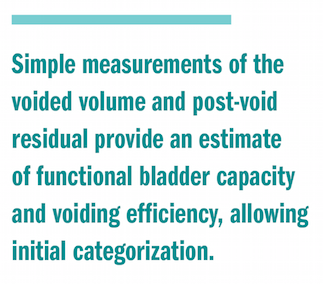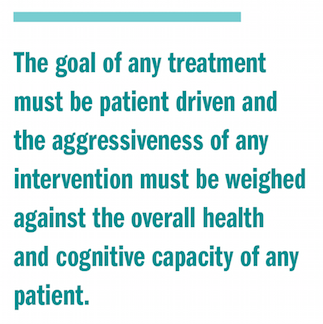Article
Underactive bladder: Definition, diagnosis, and treatment
Author(s):
After providing a definition of underactive bladder and describing its various pathologies, this article outlines practical diagnostic steps and an approach to treatment, which is aimed at correcting underlying pathologies.
Dr. Wolff is a female pelvic medicine and reconstructive surgery fellow in the department of obstetrics and gynecology at Louisiana State University Health Sciences Center, New Orleans, where Dr. Winters is chairman and professor of urology. Dr. Smith is associate professor of surgery (urology) at the University of Connecticut Health Center, Farmington. Disclosure: Dr. Winters is a consultant for Allergan and Astellas.
Underactive bladder (UAB), sometimes referred to as a weak bladder, is an increasingly recognized cause of bothersome lower urinary tract symptoms in a wide variety of patients. Although less researched than overactive bladder, in the past few years it has been gaining increasing attention, particularly in view of the increasingly aging and obese population.
While lacking an evidence-based definition at present, it has recently been described by expert consensus as a symptom complex usually characterized by prolonged urination time with or without a sensation of incomplete bladder emptying, usually with hesitancy, reduced sensation on filling, and a slow stream (Eur Urol 2015; 68:351-3).
After providing a definition of UAB and describing its various pathologies, this article outlines practical diagnostic steps and an approach to treatment, which is aimed at correcting underlying pathologies.
Next: Underlying pathologies
Underlying pathologies
As defined, UAB describes the patient experience rather than an underlying etiology. The clinical presentations as well as underlying pathophysiologies of UAB are multiple and not well understood. Historically, a decrease in detrusor contractility was considered the primary contributor of detrusor underactivity, and UAB might therefore be presumed to be the resulting symptom complex. This has not been borne out in observational studies, however.
The evolving perspective on UAB, as well as voiding/storage dysfunction in general, integrates the various aspects of disruption of brain sensory, cognitive, and motor control functions, and peripheral responses at the level of the bladder. Effective bladder emptying requires multiple systems to operate well and in concert. It depends upon intact central nervous system control, voluntary voiding, detrusor neurotransmission, and smooth muscle activity. Any of these components may be impacted by an array of pathologies.
Among the cited pathologies underlying UAB are diabetes mellitus, bladder outlet obstruction, and aging. Various central nervous system pathologies have been recognized, such as acute cerebrovascular accidents, multiple sclerosis, traumatic brain injury, and Parkinson’s disease. Injury to the peripheral nervous system supplying the bladder such as the spinal cord, cauda equina, and pelvic plexus can lead to UAB. These structures can be damaged during pelvic surgery, an array or pelvic and sacral fractures, or disk herniation. Any infectious neurologic diseases such as AIDS and Guillain-Barre syndrome may underlie UAB (Int Urol Nephrol 2014; 46[Suppl 1]:S11-21).
Next: Diagnosis
Diagnosis
The goal of evaluating a patient complaining of UAB symptoms should be primarily to discover an etiology and address its specific pathologies and, secondarily, to manage urine volume issues.
Patients experiencing symptoms of UAB complex may report hesitancy and/or an intermittent stream, and a sensation of incomplete emptying. Further questioning and testing may reveal or suggest an etiology such as those referenced above.

A focused history should address possible risk factors for UAB. History or symptoms of neurologic disease, diabetes mellitus, or prior prostate or pelvic surgery should be elicited. Additional medications such as neuroleptics, calcium channel blockers, and alpha-receptor agonists may exacerbate symptoms in otherwise at-risk individuals.
Aging is a likely risk factor for UAB. As such, comorbid frailty and a plethora of comorbid conditions can occur with the UAB symptom complex. A careful history should focus on functional status, cognitive limitations, and health care support.
Patient exam. A general survey of the patient may hint at possible etiologies of UAB. Furthermore, it may give hints about the patient’s functional and cognitive capacity. This can be augmented by a mini-mental status exam. Abdominal exam may reveal scars from prior surgeries and even possibly a distended bladder.
A careful neurologic exam should assess the integrity of lumbosacral sensations. The S2-S4 dermatomes associated with perineal and perianal sensation may be diminished or increased. Deep tendon reflexes, clonus, and the bulbocavernosal reflex should be evaluated. Especially in patients suspected of cognitive impairment, formal evaluation such as a mini-mental status examination (MMSE) should be considered (Psychopharmacol Bull 1988; 24:689-92), with appropriate co-consultation for patients with scores suggesting impaired brain function.
Next: Genitourinary exam
The genitourinary exam should be routine. In women, a pelvic exam should assess for pelvic organ prolapse. In men, a digital rectal exam gives information about BPH and sphincter tone.

The patient should be asked to show up for the exam visit with a full bladder. Simple measurements of the voided volume and post-void residual provide an estimate of functional bladder capacity and voiding efficiency, allowing initial categorization. One may consider performing a uroflow. Lower flow than expected should raise the concern for obstruction or detrusor underactivity (DU). Normal flow in the presumed absence of obstruction may indicate a filling phase problem or abnormal perceptions. Urinalysis should be performed to assess for glucose, blood, protein or infection. Patients should be asked to complete a voiding diary.
Routine imaging is not usually necessary in the initial diagnosis and workup. Ultrasound or other imaging modalities may be utilized at the provider’s discretion in more complex cases.
Next: Urodynamics
Urodynamics. There is no urodynamic definition of UAB. The utility of complex urodynamic testing has not been tested. However, urodynamics (at least a pressure/flow study) is necessary for the detection of DU or assessment of “detrusor contractility” via several recommended indices. Urodynamic parameters for DU such as detrusor strength and/or duration are poorly defined and their prognostic significance is unknown. In addition to defining the dynamics of voiding, assessment of bladder filling is also needed.
Volume sensory thresholds, bladder capacity, and sphincteric competence may all affect the patient’s perception of voiding adequacy. Thus, urodynamics may be useful to distinguish functional disorders such as volume insensitivity or dysfunctional voiding from insufficient detrusor effort or bladder outlet obstruction.
Treatment

Options for corrective management of UAB are often limited and can be difficult, especially in the presence of diminished detrusor contraction. There are no FDA-approved or validated effective oral drug options for DU. A recent review concluded that no tested agents to date, including direct cholinergic augmentation, improve voiding function in the presence of a weak detrusor contraction (Int Urol Nephrol 2014; 46[Suppl 1]:S11-21). In selected patients, neuromodulation may be of benefit (Cochrane Database Syst Rev 2009; CD004202).
Ideally, treatments should be directed at the correction of any underlying pathologies with the assumption that symptoms may resolve. The goal of any treatment must be patient driven and the aggressiveness of any intervention must be weighed against the overall health and cognitive capacity of any patient.
A particular subgroup of UAB patients consists of those with bladder outlet obstruction due to BPH, pelvic organ prolapse, or dysfunctional voiding. Relief of obstruction will depend on the etiology, with alpha-blockers, transurethral resection of the prostate, prolapse correction, or a variety of neuromodulatory techniques being viable options. Urodynamically demonstrated resolution of documented obstruction may be insufficient to resolve symptoms due to chronic end-organ damage attributable to the obstruction, and the patient should be advised that further efforts may be required.
Bethanechol (Duvoid, Urecholine), a cholinergic agonist, has not been shown to improve clinically relevant outcomes. Sacral neuromodulation has not been tested specifically for UAB, but has had promising results for non-obstructive urinary retention.
Next: Timed voiding, containment
Timed voiding may be of assistance for patients with poor sensory function. Double voiding, straining to urinate, and Crede voiding may be helpful. Ultimately, if urodynamics has been done and DU discovered, there are no medical therapies. Thus, the focus must be on volume management, often requiring some sort of catheter regimen. In many patients, especially the elderly, the frail, and the cognitively impaired, corrective therapy of any sort does not exist, and treatment often devolves to catheter strategies.
Containment (pads, diapers, etc.) can be useful in patients known to have low-pressure urine storage. In those patients with severe competing comorbidities precluding concerns of high-pressure storage and ultimate renal decline, simple diapering with overflow incontinence may be the most efficacious and reasonable option.
In most patients with UAB, the treatment principles may overlap. All options-pharmacotherapy, neuromodulation, catheterization, observation-must be considered and discussed in each clinical scenario. As in most lower urinary tract symptoms, the therapy must be directed at the individual needs of the patient.
Conclusion
Underactive bladder is an increasingly recognized cause of lower urinary tract symptoms. At present, there is no consensus on a single etiology or therapy for this condition. Careful histories and limited diagnostic studies can elucidate risk factors and can guide therapy decisions. Further research is needed to better our understanding and our treatment for this condition.
Have you read:
The promise of PD-1 ligand pathway in treating bladder cancer
Working with APPs: Best practices from a successful practice
Pediatric hypospadias repair in 2015
Subscribe to Urology Times to get monthly news from the leading news source for urologists.

















